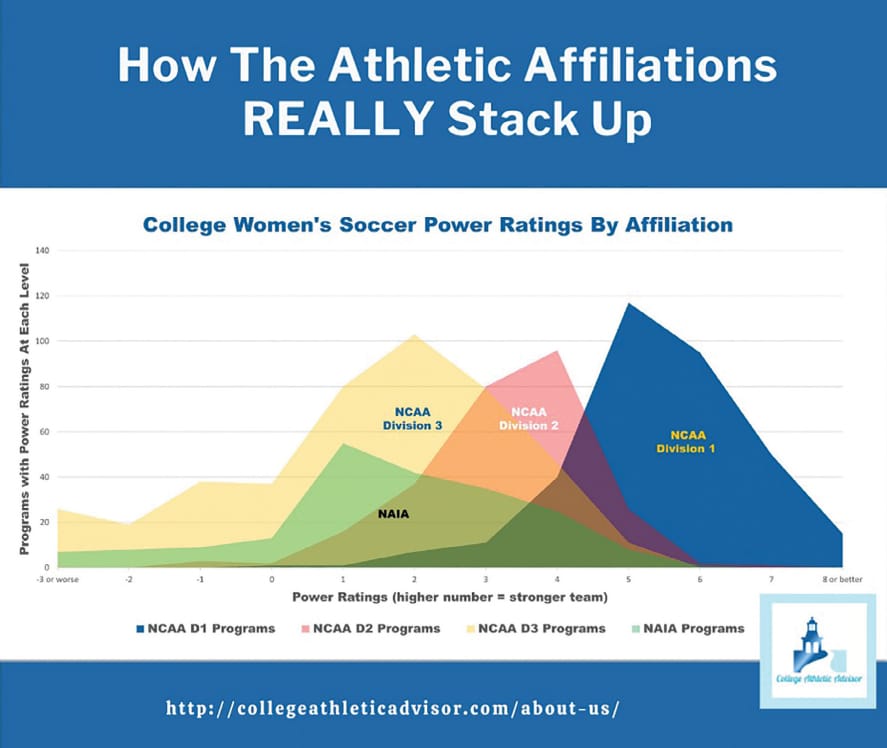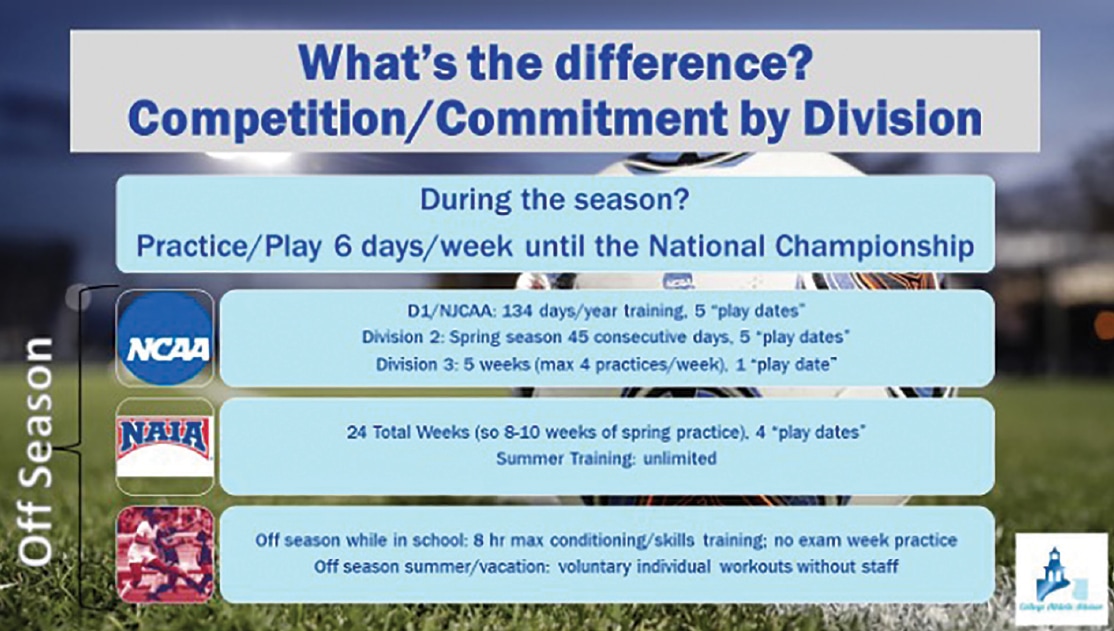There has been a lot of discussion recently in the different groups that we all frequent (IECA Member Network, Facebook IEC groups) about working with student-athletes that want to continue to play their sport in college.
We have been having numerous conversations about the state of athletic recruiting in our industry and we thought it would be fun and educational to share snippets of our exchanges addressed as three fundamental questions.
 How do you know where your student can realistically play, and what are the differences between the divisions?
How do you know where your student can realistically play, and what are the differences between the divisions?
Something Dave highlighted that I (Caleb) hadn’t considered is that when a sport is in season, no matter the division, they are all essentially the same in terms of practice time, training, and games. A baseball player at Vanderbilt (D1) is putting in as much time as a player at Washington University (D3). As one of Dave’s coaching heroes, renowned college football coach Mike Leach once said: “To me, there is nothing less relevant than the level you play at. Sure, the players overall are better, but it’s relative…If you’re defender is an All-Pro, my attacker is too. I didn’t get it then, and I don’t get it now.”
The NCAA regulates the number of games and hours per week in which players can participate (capped at 20 hours per week). The difference between a D1 program and a D3 program comes during the off-season. D1 athletes have more coach driven off-season practices and training, whereas a D3 program is driven by the players. Typically, the captains are in charge of running practices and making sure players are keeping up with their conditioning, but it is not mandatory.
In most cases, the only person that can ascertain your client’s fit at a given school is the coach at that college. The first question to ask your client is: are they nationally ranked? If they are in that elite category, that frees you to focus on building a list with the right-fit environments and making sure they are academically prepared for their aspirational schools. If they are not in that elite category of high school athlete, they need to ask college coaches at schools they are interested in attending if they fit on those rosters, which leads us to the next question and where a knowledgeable IEC can make or break a college search.
 A client just told me they want to play their sport in college. What do I need to do to help them?
A client just told me they want to play their sport in college. What do I need to do to help them?
One of our jobs as IECs is to help them create a balanced list. Only the coach at School X will know if there is a roster spot for your client. Does a balanced list consist of Tulane (NCAA D1/FBS), Penn (NCAA D1/FCS), and Middlebury (D3)? Absolutely not—all three of those schools are elite and are recruiting athletes with similar profiles, even though they are in different NCAA divisions. A top D3 soccer program is recruiting the same players as D1 schools. For elite students, those top D3 colleges may be a better academic and athletic fit than a D1 school. For example, for a young woman with the long-term goal of attending a top medical school, what environment will provide the optimal platform for her future? While there may be D1 or D2 schools interested, they may not be the best fit athletically, academically, or socially, and could be more expensive.*
Our clients benefit from our advice in determining their best-fit institutions for a successful college experience. This is where specific expertise in intercollegiate athletics can be a game changer. Being able to annotate college lists, navigate the nuances of intercollegiate athletics at different levels, understand the varying profiles of programs even at the same institution, and decode communication from coaches can all elevate our client’s options. IECA has members and resources that offer this expertise to your practice and your clients.
Once you’ve developed a balanced list, the next step is for the student to reach out to the coaches at those programs and find out if the fit is mutual. The student will need a highlight video or links to verified results (running times, Universal Tennis Rating, times for swimming, gymnastic results, etc.), a resume that includes academic and athletic information (i.e. GPA, test scores, awards, coaches’ contact information, links to social media), and a communication plan to connect with coaches. In our view, best practice is for the athlete to include this information in a brief email to the coach with an attention-grabbing subject line. Coach email addresses can usually be found on the institution’s athletic website. Depending on the responses and feedback your client receives, the list can be adjusted accordingly.
This brings us to the last question…
What is the timeline? Is it too late to be recruited?
The timeline can vary by institution, sport, gender, and the individual client. As a general rule, most elite schools would like to have completed their recruiting class by the early application deadlines. However, every year athletes sign right up until the start of the season, so if your client really wants to find a place to play, it is possible. Options begin to narrow at some point in the fall of a student’s senior year. A generic recruiting/college dual track timeline is available on Dave’s website.
Best practice would be to register with the NCAA Eligibility Center for a free account during their sophomore year, and reach out to coaches during their sophomore spring, even though coaches cannot necessarily respond with discussions about recruitment. However, if it is junior or even senior year and your client decides they want to play, then they should start reaching out to coaches. Even a baseball player in the spring season of his senior year could have opportunities, but you cannot know until you reach out to programs.
In a perfect world, a client would reach out to coaches and deeply explore their options during their junior year with an eye toward committing to their best-fit school by early fall of their senior year at the latest. The world we live in is more complicated. Injuries, significant changes to a student’s profile, and a myriad of other issues can either accelerate or delay this process. Given the level of nuance and the stakes involved, it is not surprising that it is an increasingly fertile space for expert advising.
*While we discussed the costs of college and the ways that schools discount tuition, that conversation deserves its own article.
By Dave Morris, MEd, IECA (WA), College Athletic Advisor, and Caleb Fitzpatrick, MA, IECA (CA), Magellan College Counseling
